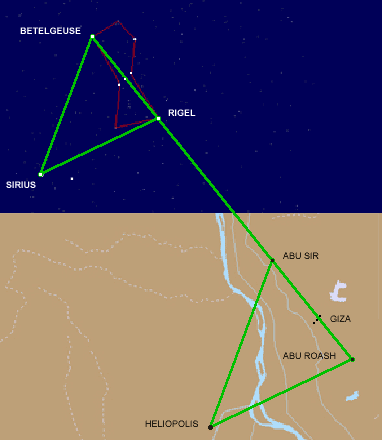
EROSION AND ASTRONOMY AT GIZA
In 1993, John Anthony West published the findings of a geologic survey of the Sphinx conducted at his request by Robert Schoch, a geologist from Boston University, that has called into question the traditional dating of the Sphinx. Although ancient Egyptian hieroglyphics do not describe the construction of the Sphinx or the Sphinx Temple, most Egyptologists believe they were built during the early historical period of ancient Egypt, at about the same time as the Great Pyramid, approximately 4,500 years ago. The head of the Sphinx was carved from a rock outcrop protruding above the Giza Plateau and the body of the Sphinx was carved out of the solid bedrock of the plateau.
For much of it's known history, the body of the Sphinx and the Sphinx enclosure has been covered with sand. During these times, the body of the Sphinx and the Sphinx enclosure were protected from erosion. Nonetheless, erosion of the body of the Sphinx and the Sphinx enclosure is much more severe than the erosion of other structures constructed by ancient Egyptians. Unlike the horizontal erosion features that may be attributed to the wind and sand that blows across the Giza Plateau, Schoch concluded that the vertical erosion evident on unrestored portions of the Sphinx, and to an even greater extent on the walls of the Sphinx enclosure, had to be water erosion from long periods of heavy rainfall.

Because the Giza Plateau has been an arid desert with very little rainfall for the past 7,000 years, West, Schoch and others believe that the water erosion evident on the Sphinx proves that it must have been carved prior to that time.
The sun rises due east all over the world on only two days a year, the spring and autumn equinoxes. Each of the twelve constellations of the zodiac rises before the sun on the spring equinox for approximately 2,148 years, and is then replaced by the next constellation along the zodiac. Art and architecture have commemorated these astronomical ages since remote antiquity. The bull symbolized the Minoan civilization, known to have existed during the Age of Taurus. The New Kingdom of ancient Egypt carved ram's heads on the sphinxes at Thebes, signifying the Age of Aries. Jesus Christ was born soon after the Age of Pisces began, and the fish is a universal symbol of Christ and Christianity. The Great Sphinx at Giza looks due east. The last time Leo the lion rose due east, before the sun on the spring equinox, was over 10,500 years ago. The image below was generated by Skyglobe shareware, simulating the eastern view of the horizon from the Giza Plateau, just before sunrise on the spring equinox in 11,500 BC.
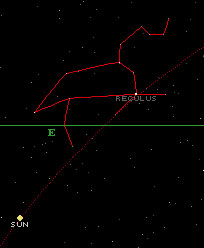
Further evidence that the Sphinx was intended to commemorate Leo and the Age of Leo was provided by Robert Bauval in 1993 when he described the correlation between the three pyramids on the Giza Plateau and the three belt stars of Orion. Bauval had noticed that the slight offset of the smaller pyramid matched the slight offset of the dimmer star in Orion's belt. The angle from the apex of the first pyramid to the apex of the third pyramid is approximately 52° south of due west. The best match between this alignment of the pyramids at Giza and the alignment of the belt stars above the souther horizon as they crossed the meridian, occurred just before sunrise on the spring equinox around 11,500 BC, at the same time that Leo was rising due east, directly in front of the Sphinx.
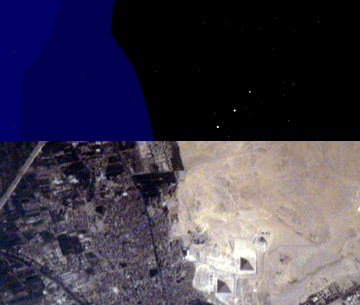
The upper portion of the image above is a Skyglobe simulation of Orion's belt just above the southern horizon before dawn on the spring equinox in 11,500 BC. The lighter area to the left (east) is the Milky Way. The lower portion of the image is a photograph of the Giza Plateau taken from the space shuttle on August 15, 2001. In this photograph south is up, and the darker area on the left half of the photo is the Nile Valley east of Giza. The ancient Egyptians are known to have deified the stars in the constellation of Orion and they are also known to have considered the Nile to be the terrestrial equivalent of the Milky Way.
Julius Oppert, the founder of the modern school of Assyriology, reported that "ancient Egyptians calculated by cycles of 1,460 years-zodiacal cycles tied to the heliacal rising of Sirius, the brightest star in the sky. Their year consisted of 365 days which caused them to lose one day in every four years, and consequently, they would attain their original starting point again after 1,460 years (365 x 4). The zodiacal cycle ending in the year 139 of our era commenced in 1,322 B.C. [These widely accepted beginning/ending dates of the ancient Egyptian cycle were based on the heliacal rising of Sirius, the brightest star in the sky.] The Assyrian cycle was 1,805 years, or 22,325 lunations. An Assyrian cycle began in the year 712 B.C. Chaldean records state that between the deluge and their first historic dynasty there was a period of 39,180 years. This stands for 12 Egyptian zodiacal cycles plus 12 Assyrian lunar cycles:
| 12 x 1460 = 17,520 | ) |
| : = 39,180 | |
| 12 x 1805 = 21660 | ) |
These two modes of calculating time are in agreement with each other, and were known simultaneously to the Chaldeans. Building up the series of both cycles, starting from our era, the result is as follows:
| Zodiacal Cycle | Lunar Cycle |
| 1,460 | 1,805 |
| 1,322 | 712 |
| --------- | --------- |
| 2,782 | 2,517 |
| 4,242 | 4,322 |
| 5,702 | 6,127 |
| 7,162 | 7,932 |
| 8,622 | 9,737 |
| 10,082 | 11,542 B.C. |
| 11,542 B.C. |
At the year 11,542 B.C. the two cycles came together, and consequently they had on that year their common origin in one and the same astronomical observation."
One of the oldest surviving ancient Egyptian astronomical illustrations is from the tomb of Senenmut, the chief architect and astronomer during the reign of Queen Hatchesput. (c. 1473-1458 B.C.) The three stars of Orion's belt are prominently displayed in the middle of the upper panel, above a figure that signifies Orion, and the figure topped by an orb just to the left of the belt stars signifies Sirius in relation to Orion.. The lower panel describes lunar cycles and the figures topped by orbs along the bottom of the illustration signify Sirius at different times in different positions in the sky.
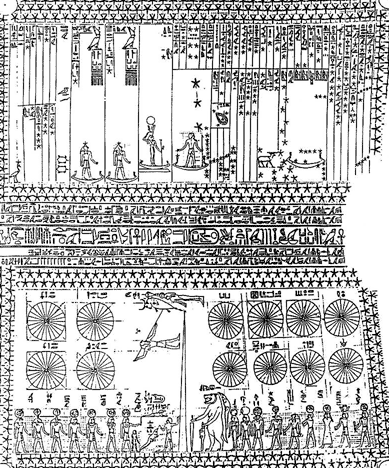
Vega was the northern polestar around 11,500 B.C. Vega is the brightest star in the northern hemisphere and is by far the brightest star along the path of the celestial north pole. After Sirius, Canopus is brightest star in the sky and Canopus is by far the brighest star along the path of the celestial south pole. Canopus was also the southern polestar around 11,500 B.C. The fact that the brightest northern and southern stars along the paths of the celestial poles were both polestars around 11,500 B.C. could also explain why this date was selected as the starting point of these ancient calendrical systems and was memorialized vis-a-vis the Sphinx and the correlation between Orion's belt and the pyramids at Giza.
In 1964 Alexander Badawy and Virginia Trimble observed that the upper shafts in the Great Pyramid pointed at the meridian transits of Orion's belt to the south and Thuban to the north, during the era when the Giza pyramids are believed to have been completed, around 4,500 years ago. Located in the constellation of Draco, Thuban was the polestar at that time.
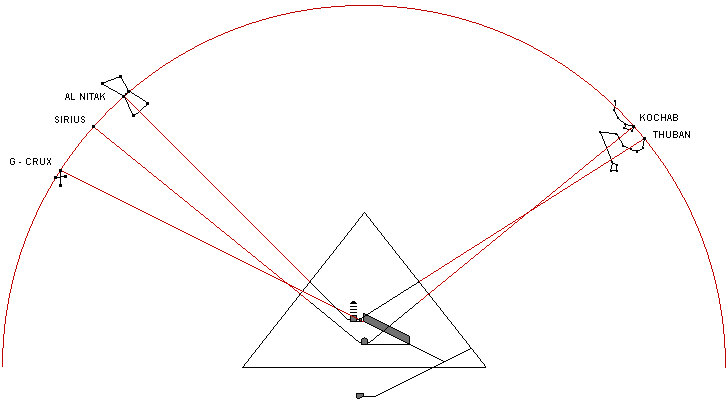
Gantenbrink's precise measurement of the angles of the upper shafts enabled Robert Bauval to show that the upper southern shaft pointed directly at Al Nitak around 2,500 B.C. This is the same star in Orion's belt that corresponds to the Great Pyramid in Bauval's correlation theory between the three pyramids at Giza and the three stars in Orion's belt. Bauval also demonstrated that the lower shafts pointed to the meridian transits of Sirius in the south and Kochab in the north, around 2,500 B.C. Sirius is the brightest star in the sky and as Thuban slowly moved away from the celestial north pole as a result of precession, it was replaced by Kochab as the Polestar. As the years advanced during the pyramid age, the height of the meridian transit of Sirius was increasing in the southern sky, while the height of the meridian transit of Kochab was decreasing in the northern sky. As a result, there was a time when both stars were at the same height above the horizon as they crossed the meridian. This occurred around 2,437 B.C., when both stars crossed the meridian approximately 39° 19' above the horizon. This is very close to the 39° 17' angle generated by the 9/11 slope of the lower shafts.
The combined length of the ascending passage and the grand gallery from the beginning of the floor of the ascending passage to the end of the sloping floor of the gallery at the great step located at the mid line of the pyramid is 160 cubits. The length of the floor of the ascending passage is 72 cubits and the length of the sloping floor of the gallery is 88 cubits. 72/88 is also equal to 9/11. Inclined at 26° 13' above the horizon, the ascending passage and the grand gallery pointed at the meridian transit of Gamma Crux, the upper star of the Southern Cross, around 2,500 B.C. At that time the Southern Cross was slowing sinking in the sky as a result of precession and dynastic Egypt came to an end at approximately the same time that the Southern Cross stopped rising above the horizon at the latitude of Giza, around the beginning of the current era. In 11,500 B.C. the Southern Cross was slowly rising in the southern sky above Giza and at that time the meridian transit of Gamma Crux was also 26° 13' above the horizon. Before the pyramid was completed around 2,500 B.C. Gamma Crux would have shined directly down the grand gallery and the ascending passage when it crossed the meridian. This would also have been true in 11,500 B.C. if the pyramid had been partially built up to the level of the grand gallery or the ascending passage at that time. The hieroglyphic meaning of the ancient Egyptian cross was life and in some contexts, eternal life. If the ancient Egyptian cross was related to the Southern Cross, then the circle at the top of the ancient Egyptian cross corresponds with Gamma Crux.
| Khufu | 2,551 - 2,528 | Giza | |
| Djedefre | 2,528 - 2,520 | Abu Roash | |
| Khafre | 2,520 - 2,494 | Giza | |
| Nebka | 2,494 - 2,490 | Z. El-Aryan | |
| Menkaure | 2,490 - 2,472 | Giza | |
| Userkaf | 2,465 - 2,458 | Saqqara | |
| Sahure | 2,458 - 2,446 | Abu Sir | |
| Neferirkare | 2,446 - 2,426 | Abu Sir | |
| Shepsekare | 2,426 - 2,419 | Abu Sir | |
| Raneferef | 2,419 - 2,416 | Abu Sir | |
| Niuserre | 2,416 - 2,388 | Abu Sir |
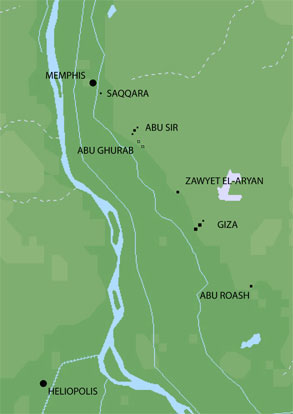
Userkaf and Niuserre also built large sun temples at Abu Ghurab. Egyptologist Miroslav Verner has noted that the diagonal line formed by the southeast corners of the three main pyramids at Giza points towards ancient Heliopolis and that the diagonal line formed by the northwest corners of Sahure, Neferikare and Raneferef's pyramids at Abu Sir also points towards Heliopolis. As the course of the Nile moved eastward during the dynastic period of ancient Egypt, the capital city of Memphis also moved eastward. The location shown on these maps is the site of the oldest ruins of Memphis, from the pre-dynastic and early dynastic period. Chris Tedder noted the alignment of these sites in 2002. A diagonal line from the pyramid at Abu Roash to archaic Memphis has an azimuth of 51.85 south of due east. This is the same angle as the slope of the faces of the Great Pyramid. In between Abu Roash and Memphis, this line crosses over Giza, Nebka's pyramid at Zawyet El Aryan, the sun temples of Userkaf and Niuserre at Abu Ghurab, Suhare's pyramid at Abu Sir, and Userkaf's pyramid at Saqqara.
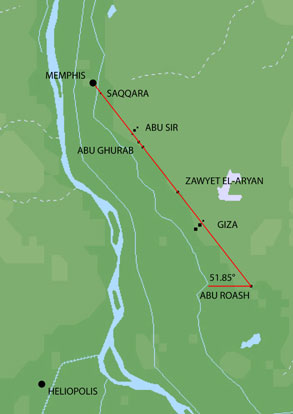
In 2003 Graham Chase demonstrated that the angular dimensions of the celestial triangle formed by Sirius, Betelgeuse and Rigel match the angular dimensions of the terrestrial triangle formed by Heliopolis, Abu Sir and Abu Roash. Just as the line from Betelgeuse to Rigel crosses over Orion's belt, the line from Abu Sir to Abu Roash crosses over the pyramids at Giza. 4,500 years ago the alignment of Orion's belt above the horizon matched the alignment of the pyramids at Giza, when Orion's belt was 51.85 east of due south. At that time, a sight line could be drawn from from Abu Roash through Abu Sir, across the horizon and up into the sky through Rigel and Betelgeuse. This may explain why pyramids were built along this sight line at Abu Roash and at Zawyet El Aryan during pyramid construction at Giza.
